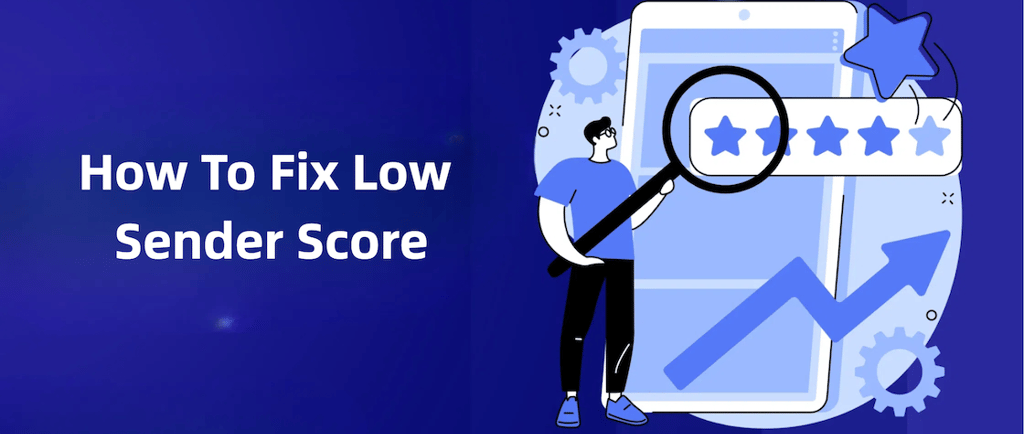How to Fix Low Sender Score
A high sender score typically means your emails reach their intended inboxes, while a low sender score can lead to the opposite.
5/15/20243 min read


Your Sender Score is Low?
Your email sender score plays a critical role in the success of your email campaigns. A high sender score typically means your emails reach their intended inboxes, while a low sender score can lead to the opposite.
These scores are mainly assigned by mailbox providers and internet service providers (ISPs) to evaluate how trustworthy a sender is. Neglecting proper email list maintenance and adopting poor email marketing practices can result in a low score that is challenging to improve.
Checking Your Sender Score
The sender score algorithm is a free service provided by the Return Path Provider Network, which compiles reputation metrics to generate a sender score for a specific IP address.
Scores range from 0 to 100, indicating how effective a sender is at sending emails. A sender’s score can fluctuate based on various email marketing metrics. To check your sender score:
Visit the Sender Score website.
Create and register an account using your professional email address.
Confirm your account through the email sent to you.
Log in and enter an IP address or domain to generate a report showing various sender scores.
The report will reveal whether the IP or domain has been sending quality messages or spam-like content in the last 30 days. Key metrics in the report include:
Complaints: The number of complaints your IP receives compared to others.
Volume: The total number of emails sent and how many received complaints.
External Reputation: How your IP compares to others, based on whitelist and blacklist appearances.
Unknown Users: The frequency of attempts to send emails to invalid addresses.
Accepted/Rejected Rates: Ratios of messages accepted for delivery versus those bounced.
A sender score above 80 indicates good email practices, while a score below that suggests issues.
Why Is My Sender Score Low?
Several factors can contribute to a low sender score, including:
Inconsistent email volume
Erratic sending frequency
Sending from a new IP address
Being added to a blacklist
Triggering spam traps
Being reported as a spammer
Poor performance metrics, such as high spam complaints, high bounce rates, and low open rates, affect your sender reputation. Understanding how your actions impact these metrics is crucial for maintaining a good reputation.
Improving and Maintaining Your Sender Score
To enhance your sender score, follow these best practices:
1. Apply Email Authentication Protocols
Authenticating your sender account ensures that only authorized IP addresses can send messages using your domain, preventing spam-like activity. Key protocols include:
DomainKeys Identified Mail (DKIM): Provides a digital signature that proves the authenticity of your emails.
Sender Policy Framework (SPF): Allows senders to specify authorized mail servers to prevent domain spoofing.
2. Set Up Separate Email Sub-Accounts
Separate marketing and transactional messages by using sub-accounts. This allows for better tracking of email metrics and ensures that issues with marketing emails do not affect transactional messages.
3. Keep Track of Your Email Engagement
Monitor engagement metrics such as open rates, click rates, complaint rates, engagement time, and unsubscribe rates. Improving these metrics takes time and effort, but they are essential for enhancing your sender score.
4. Perform Segmentation, Testing, and Personalization
Segment your email lists based on criteria like interests and demographics to send more relevant content. A/B testing different email versions can help identify effective strategies.
5. Have a Checklist for Your Email Marketing Campaigns
Create a checklist of best practices to follow before sending emails. This should include:
A compelling subject line
An eye-catching pre-header
Functional links
Proofread content
Quality calls-to-action (CTAs)
6. Ensure Your Emails Are Targeted and Relevant
Personalizing your email content ensures that subscribers receive messages that interest them, which can improve engagement and sender scores.
7. Send Emails to Permission-Based Contacts
Only send emails to contacts who have opted in to receive your communications. Avoid purchased email lists, as they can lead to low engagement and spam complaints.
8. Practice Good Email List Hygiene
Regularly clean your email list by removing inactive subscribers. Sending emails to unresponsive addresses can increase bounce rates and negatively impact your sender score.
9. Send Messages Using Your Own Domain
Using your own domain for sending emails enhances your sender reputation. Free email providers can limit your ability to implement authentication protocols and grow a good sender reputation.
The Takeaway
Your sender score directly affects whether your messages reach your contacts' inboxes. A low sender score can lead to reduced deliverability, while a high score improves results. Regularly check your IP reputation using the Sender Score website to understand your standing with ISPs and mailbox providers.
By following the tips outlined in this article, you can improve your sender reputation and achieve a better sender score for future email campaigns.
Your Email Marketing Partner
Address - Shanghai, China
© 2024. All rights reserved.
Inguzleap 千竞传播
contact@inguzleap.com
